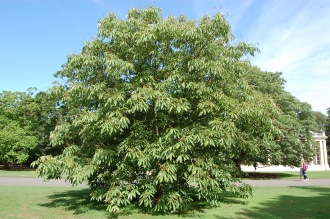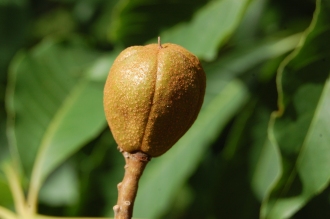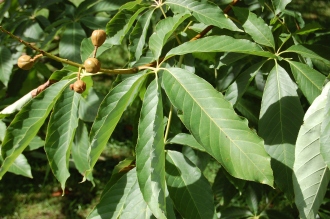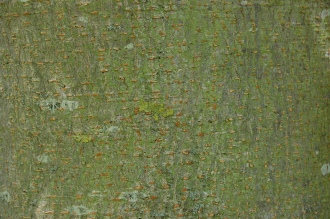Position: Full sun to partial shade
Flowering period: Late spring to early summer
Soil: Moist, well drained
Eventual Height: 26m
Eventual Spread: 20m
Hardiness: 7a, 7b, 8a, 8b, 9a, 9b, 10a
Family: Sapindaceae
Aesculus indica is a deciduous tree with a domed habit. Its dark green leaves are palmately compound with five leaflets. Its leaflets are narrowly ovate with serrulate margins, up to 20cm long and 7cm broad. Its leaves may turn yellow/ orange before they fall in autumn. Its grey/ green bark is smooth and flaky with orange/ beige lenticels. Its hermaphroditic pale pink/ white flowers are up to 3cm long and are produced in erect panicles which are up to 20cm long. Its fruit is a round smooth capsule, containing a single large seed.
Aesculus indica, commonly known as Indian Horse Chestnut, is native to the Himalaya from Afghanistan and Pakistan to western Nepal. In its native habitat it grows in wet temperate forests and shaded ravines.
The etymological root of the binomial name Aesculus is from the ancient Latin name for the Horse Chestnut (Aesculus hippocastanum). Indica is from the Latin meaning ‘from India’.
The landscape architect may find Aesculus indica useful as an attractive specimen tree. It should be noted the seeds of this tree may be potentially toxic if ingested.
Ecologically, Aesculus indica flowers are attractive to pollinating insects.
The Royal Horticultural Society have given the cultivar Aesculus indica ‘Sydney Pearce’ their prestigious Award of Garden Merit in 2002.
Aesculus indica prefers moist, well-drained calcareous soils. It tolerates most pH of soil.
Aesculus indica requires little maintenance. Dead or diseased material may be removed in early spring.
![]()
Landscape Architecture








Leave a comment